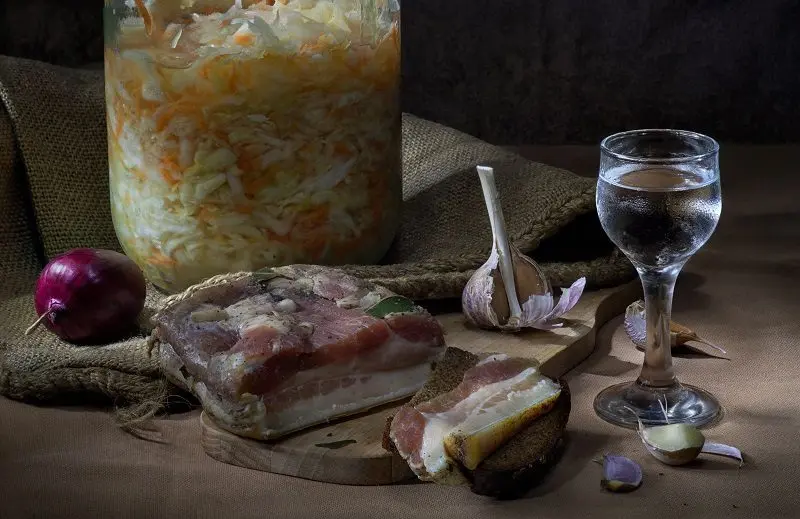Contents
Sauerkraut with vodka retains its taste longer than usual and remains crispy. At the same time, the cooking process itself is not complicated. The finished dish can be served as a separate dish and an appetizer for vodka (previously seasoned with vegetable oil and fresh onions), used as an ingredient for salads and vinaigrettes, or as a filling for pies and pies.
Theory
Fermentation is lactic acid fermentation, during which a natural preservative appears – lactic acid, which forms a recognizable “fermented” taste and aroma of vegetables (mainly cabbage and cucumbers). It is lactic acid that prevents spoilage of vegetable pulp – it suppresses pathogenic microflora: bacteria and fungi.
The problem is that an excess amount of lactic acid “corrodes” vegetables – it makes them soft, tasteless, the characteristic crunch disappears, and a burning aftertaste appears. To slow down this process (you won’t be able to stop it completely), after a certain period of fermentation, when enough lactic acid has been produced for canning, vodka is added to sauerkraut, which stops lactic acid fermentation. A similar technology is used for pickling and pickling cucumbers.
Vodka can be replaced with diluted water up to 40% vol. ethyl alcohol or quality odorless moonshine (preferably double distillation).
White cabbage of mid-season and late-ripening varieties is suitable. Pickled early varieties resemble boiled cabbage in consistency, they are characterized by a herbal flavor. The leaves should be firm and juicy, with thin veins.
Since the amount of alcohol is minimal, it is not felt in taste, and the cabbage itself will contain less alcohol than kvass and kefir.
Ingredients for a 3 liter jar:
- white cabbage – 2-2,2 kg;
- carrots – 1 piece (medium);
- water – 1,5 liters;
- vodka – 3 tbsp. spoons;
- sugar – 2 tbsp. spoons;
- salt – 2 tbsp. spoons.
Salt and sugar are only needed to balance the taste. You can also add any seasonings and spices to the cabbage (peppercorns, bay leaves, etc.). It is not recommended to add table vinegar.
vodka sauerkraut recipe
1. Remove the top leaves from the cabbage, cut the heads with a knife into several parts, then chop the flesh with a knife, on a grater or food processor. Heads are not needed.
To obtain a characteristic crispy taste, the slices must be sufficiently wide and long. The larger the shredder, the more vitamins the cabbage retains.
2. Peel and grate the carrots on a coarse grater. It is advisable not to exceed the amount indicated in the recipe – sauerkraut turns yellow from an excess of carrots.
3. Mix cabbage with carrots. Place the resulting vegetable mixture in a jar or plastic container for sourdough. Lightly tamp.
4. Heat up the brine water to +35-40 °C. Add salt. Stir until the salt is completely dissolved.
5. Pour the brine into the cabbage (the liquid should cover the cabbage layer by at least 1-2 cm). Depending on the size of the cut, 1,2-1,5 liters will be required.
6. Bandage the neck of the container with gauze. Put the jar (container) with cabbage on a drip tray or in a deep bowl. During fermentation, the brine will spill out of the jar.
7. Leave the cabbage to ferment for 3 days in a dark place at room temperature. 2-3 times a day, remove foam from the surface, pierce a layer of cabbage with a knife or a wooden stick in the center to the very bottom to release carbon dioxide. If you do not release the gas, the finished sauerkraut will be bitter.

It is very important that during fermentation the top layer does not remain without liquid, therefore, if necessary, the cabbage should be lightly tamped.
8. After 3 days, drain the solution into a separate container (do not squeeze the cabbage). Add vodka and sugar to the liquid, mix. Pour the brine back into the cabbage. Close the lid tightly. Place the container in a dark, cool place (+1-5 °C), such as a refrigerator or cellar. The lower the temperature, the better, but it is important to prevent freezing – the taste will deteriorate greatly.
For long-term storage for the winter, it is better to leave cabbage with vodka in brine in liter jars rolled up with a metal lid with an enameled inside.
The recommended shelf life of sauerkraut in jars is up to 15-20 days, then the taste gradually deteriorates, so it is advisable to cook the dish in small batches and eat it immediately after fermentation.










